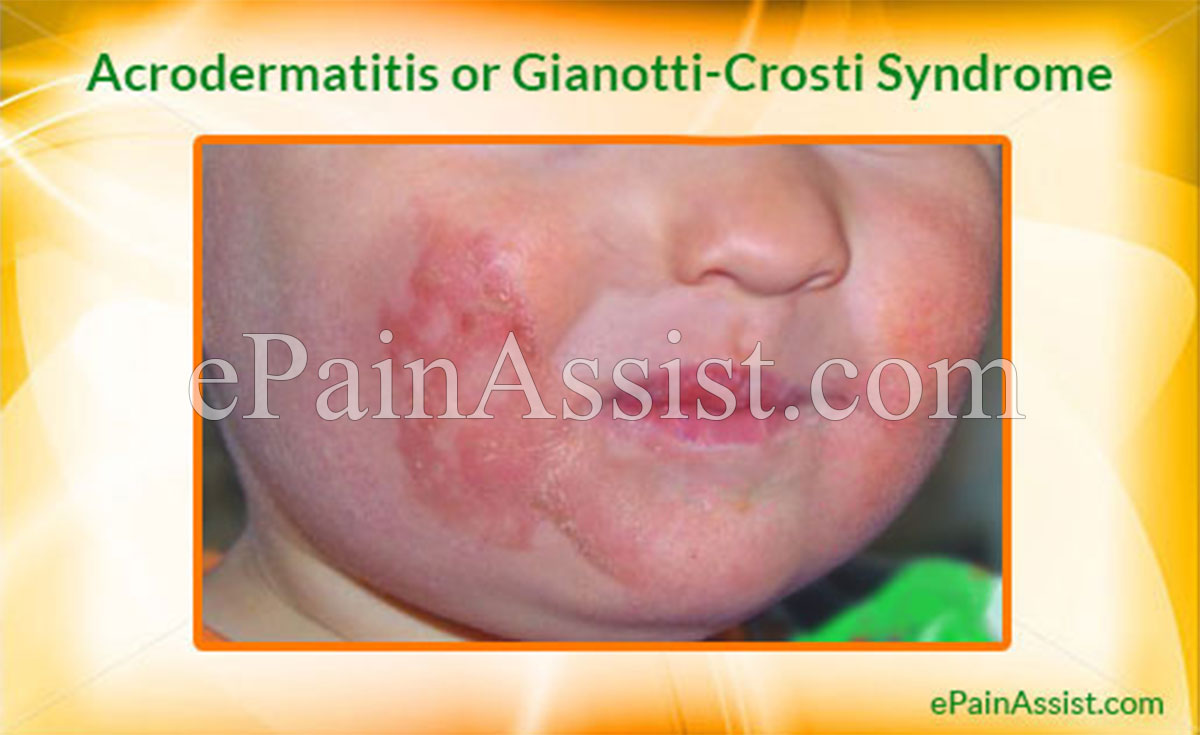Acrodermatitis, also known as papular acrodermatitis of childhood and Gianotti-Crosti syndrome, is a rare medical condition of the skin occurring in childhood. Acrodermatitis can also be accompanied with hepatitis B and other viral infections. Children who are aged between 6 months and 12 years are commonly affected by acrodermatitis. Children who are not suffering from acrodermatitis, but are in contact or live near children suffering from it can have this condition at the same time. Acrodermatitis can also be accompanied by other symptoms, such as fatigue, fever, blisters on the body which are red to purple in color and are itchy. Treatment comprises of treating the underlying condition, cortisone creams and antihistamines.

Causes of Acrodermatitis or Gianotti-Crosti Syndrome
- The exact cause of Acrodermatitis or Gianotti-Crosti Syndrome is not clear. However, its relation with other viral infections is well understood.
- Acrodermatitis or Gianotti-Crosti Syndrome often occurs in Italian children who have hepatitis B, however, this relation is rarely observed in the United States.
- Virus which is commonly associated with Acrodermatitis or Gianotti-Crosti Syndrome is the Epstein-Barr virus.
- Other viruses which are involved and can contribute to Acrodermatitis include cytomegalovirus, parainfluenza virus, coxsackie viruses, respiratory syncytial virus (RSV) and other live virus vaccines.
- Children whose siblings have had Acrodermatitis or Gianotti-Crosti Syndrome or who are in contact with other kids with acrodermatitis commonly develop this condition.
- Children suffering from Down’s syndrome also are at a slightly higher risk for having acrodermatitis.
- Another type of acrodermatitis is acrodermatitis enteropathica which is a genetic form and is occurs rarely. In this type, there is poor absorption of zinc from the diet. Acrodermatitis enteropathica is also related with development delays and other abnormalities. Increasing zinc intake and zinc supplements helps with this condition.
Signs and Symptoms of Acrodermatitis or Gianotti-Crosti Syndrome
- Appearance of red spots on the child’s skin.
- These spots are commonly seen on the arms, buttocks and thighs, but they can develop anywhere on the body.
- The disease starts in the legs and spread upwards to the face. Rash never appears on the trunk of the body and this feature is important in diagnosis.
- As the disease progresses, the red spots turn purple indicating leakage of blood into the affected regions.
- Later fluid filled blisters which itch develop in place of spots.
- There may be series of bumps on the skin.
- Tenderness and swelling in the lymph nodes and abdomen.
- Appearance of a copper-colored spot on the skin may also be an indication of acrodermatitis. This spot is usually flat and firm to touch.
- If Acrodermatitis or Gianotti-Crosti Syndrome occurs, as a result of hepatitis B, then the patient will have yellow hue to the eyes and skin, which is a sign of jaundice.
Investigations for Acrodermatitis or Gianotti-Crosti Syndrome
Physical exam which reveals the rashes and blisters is usually sufficient for diagnosis. The spleen, liver, and lymph nodes could also be swollen. Tests done for further confirmation of diagnosis and to exclude other medical conditions are:
- Bilirubin level.
- Hepatitis B surface antigen or hepatitis virus serology.
- Liver function tests.
- Serum zinc level for confirming or excluding acrodermatitis enteropathica.
- Screening for EBV antibodies.
- Biopsy of the skin.
Treatment for Acrodermatitis or Gianotti-Crosti Syndrome
- Treatment of Acrodermatitis or Gianotti-Crosti Syndrome comprises of treating its cause, such as viral infections like hepatitis B and Epstein-Barr.
- Cortisone creams/ointments help with relieving the itching.
- Antihistamines are prescribed if the child has any allergies.
- The eruptions or rashes of acrodermatitis usually go away on their own in a month or so. The maximum time taken for them to resolve is around four months.
- If hepatitis B is the cause of acrodermatitis, then recovery can take six to 12 months for the liver to get better.
- Acrodermatitis or Gianotti-Crosti Syndrome doesn’t usually recur.
- Treatment for acrodermatitis enteropathica involves zinc supplements to increase the level of zinc in the body. Restoration of the zinc levels resolves acrodermatitis enteropathica.
- If the child shows symptoms of papular acrodermatitis, then immediate medical attention should be sought.
The prognosis of Acrodermatitis or Gianotti-Crosti Syndrome is often good, as it usually resolves on its own without treatment. Other associated medical conditions, such as Epstein-Barr and hepatitis need close monitoring, as they can cause complications.
- Indian Journal of Dermatology – “Gianotti-Crosti syndrome: A comprehensive overview” (https://www.ncbi.nlm.nih.gov/pmc/articles/PMC4811469/)
- StatPearls – “Gianotti-Crosti Syndrome” (https://www.ncbi.nlm.nih.gov/books/NBK539872/)
Also Read:
